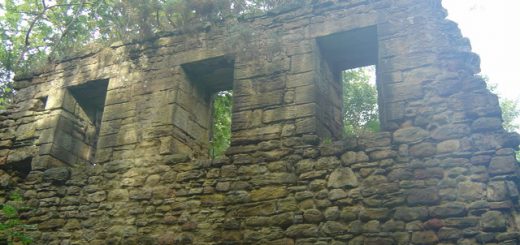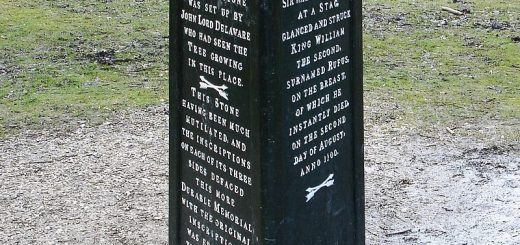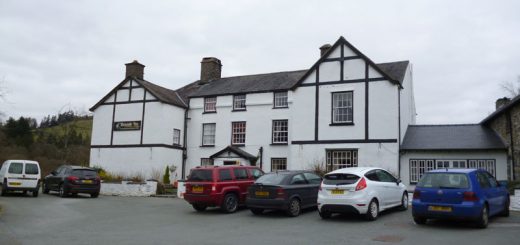Plas-yn-Rhiw
Plas-yn-Rhiw is a 16th Century manor house which overlooks Hell’s Mouth (Porth-y-Neigwl) on the Lleyn Peninsula. There has apparently been habitation at the site for over a thousand years, for there was a fortified house on the site in around 900AD built by Meirion Goch (a noble man of the minor gentry) to prevent incursions by Vikings into Porth-y-Neigwl. The mansion house has a long and well documented history, and its most recent owners were the three old eccentric Keating sisters (Eileen, Lorna and Honora) who bought the house in 1938-1939 and restored and refurbished it with advice from Clough Williams-Ellis, after they traced their ancestry to its original owners. It had previously been vacant since 1922. Now the National Trust owns the house and has maintained it as it was in the late 1930’s.
 Plas-yn-Rhiw is allegedly haunted by at least two ghosts, the first one, an 18th Century drunkard who owned the house and is looking for another drink, and the second, is the weeping ghost of a young Victorian girl who was the daughter of an owner, who ran away to marry a tinker.
Plas-yn-Rhiw is allegedly haunted by at least two ghosts, the first one, an 18th Century drunkard who owned the house and is looking for another drink, and the second, is the weeping ghost of a young Victorian girl who was the daughter of an owner, who ran away to marry a tinker.
Taken from the ‘society’ ghost book ‘True Ghost Stories’ compiled by Marchioness Townshend of Raynham and her friend Maude M C Ffoulkes published in 1936, this is the experience of one of their society upper circle whilst staying with Lady Strickland of Sizergh Castle, Cumbria, who rented Plas-yn-Rhiw for two summers.
‘In the summer of 1892, I was staying with my friend the late Lady Strickland, at an old manor house called “Plas-yn-Rhiw”, near Pwllheli. I was the only visitor, and one night Lady Strickland and I sat up so late playing cards that it was long past midnight when we prepared to go to bed. In view of what happened, I should mention that the servants of “Plas-yn-Rhiw” (who had all gone to bed long before) slept in another wing, and as they used the back staircase to go to their rooms, no one but ourselves could possibly be using the front staircase at that hour.
‘The old house was in absolute stillness, and the moonlight lay in pools of silver on the oak staircase. My bedroom, on the first floor, faced the landing, and Lady Strickland, who slept on the floor above me, was just in the act of lighting her candle from mine, when we heard heavy footsteps coming upstairs from the hall. The steps were slow and hesitating, apparently those of an old man, and they were accompanied by the sound of laboured breathing, punctuated by various degrees of coughing.
“Who’s that coming upstairs?”
‘There was no reply – we looked over the balusters, but although the coughing and wheezing came nearer and nearer, we saw no one. By this time we were too scared to move, our candlesticks fell to the ground, and we clung to each other in fear of the unknown. The steps paused for a moment beside us, as if the unseen owner of the feet had stopped to take breath. He then continued his upwards progress, until the coughing gradually died away and we heard no more.
‘I implored my hostess not to go up to her bedroom, but to share mine, or any other on the first floor, but she refused, saying: “I have some Holy Water in my room, and with spiritual protection I fear nothing.”
Lady Strickland asked discreetly round the neighbourhood and discovered that Plas-yn-Rhiw had once been owned by ‘an old reprobate squire, who drank himself to death’ and was told that his earth-bound spirit occasionally returned, ‘vainly trying to obtain some gratification for his ceaseless thirst’.
The second ghost at Plas yn Rhiw is a classic Victorian maiden who gave up her secure life with a prominent family to elope with a tinker. It is thought that the girl was called Annie Elizabeth Williams, born around 1840 to the owners of the house. She encountered the tinker (of unknown identity) by way of accident when he wandered to the house looking for work. Annie was young and gullible, she had not travelled more than a dozen miles from the house in her whole life, and was confronted by a handsome man who travelled the country and could tell her of the magnificent life beyond the peninsula. The girl’s father did not approve of the tinker and sent him away, but he returned time after time, secretly meeting with Annie. After a while, the couple decided to elope since they would not get consent to marry. One night Annie packed a few belongings and left the house to meet the tinker at a pre-arranged rendezvous. It is thought that they walked through the night to Pwllheli and boarded a train the next morning. When Annie’s father discovered that she had disappeared, he suspected that she had eloped with the tinker and saddled a horse. He reached the railway station at Pwllheli minutes too late, the train was already heading out towards Bangor, and he had no chance of catching it, or stopping it, even with his authority. When Annie and the tinker reached Bangor, they changed trains and travelled to Holyhead so they could catch a boat for Ireland. It is thought that Annie pawned her possessions to finance the journey, and it is not known if they ever reached Ireland, for the tinker abandoned Annie leaving her penniless. Annie must have made her own way in life, for she never returned home. Later residents of Plas-y-Rhiw have allegedly heard the spirit of Annie Williams crying piteously in the bedroom that was once hers. The ghost of a young woman wearing a white dress has been seen in the house, which is thought to be that of Annie.




Recent Comments